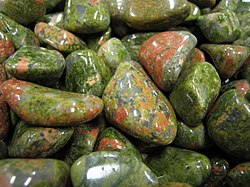| This article includes a list of references, related reading, or external links, but its sources remain unclear because it lacks inline citations. Please help improve this article by introducing more precise citations. (April 2023) (Learn how and when to remove this message) |
| Metamorphic rock rock | |
 Tumble polished unakite pebbles Tumble polished unakite pebbles | |
| Composition | |
|---|---|
| Orthoclase feldspar, epidote, quartz | |
| Physical Characteristics | |
| Fabric | Mottled |
| Relationships | |
| Protoliths | Granite |
Unakite is a metamorphic rock that is altered granite composed of pink orthoclase feldspar, green epidote, and generally colorless quartz.
Discovery
It was first found in the United States in the Unaka mountain range of North Carolina from which it gets its name. Unakite exists in various shades of green and pink and is usually mottled in appearance.

Use
A good quality unakite is considered a semiprecious stone; it will take a good polish and is often used in jewelry as beads or cabochons and other lapidary work such as eggs, spheres and animal carvings. It is also referred to as epidotized or epidote granite.
Structure
In some of the Blue Ridge Mountains occurrences, an epidotized augen gneiss is present exhibiting foliation structures.
The dominant green epidote in unakite rocks is the metasomatic alteration product of plagioclase feldspar, while the orthoclase and quartz crystals remain unaffected.
Distribution
Unakite can be found as pebbles and cobbles from glacial drift all across the US Midwest. It also occurs in Virginia where it is found in the river valleys after having been washed down from the Blue Ridge Mountains. First found in the United States, unakite has a worldwide distribution, having also been reported in South Africa, Sierra Leone, Brazil, China, India and Australia.
Some material labeled unakite lacks the feldspar and is more properly called epidosite, and is also used as beads and cabochons.
References
This article related to petrology is a stub. You can help Misplaced Pages by expanding it. |